Wins for Chelsea and 2-IMMERSE at Wembley
A report from our man on the terraces, DOUG WILLIAMS from BT R&D:
2-IMMERSE is developing a live service prototype based on football that we aim to test at the FA Cup final on 19 May this year. Several 2-IMMERSE project participants gave up this last weekend to take part in key technical tests to prepare for that event. The test took place at Wembley Stadium during the FA Cup semi-final between Chelsea and Southampton.

Getting experience of all that is required for the Wembley trial incorporates a number of fundamental and non-trivial milestones, including knowing what we have to do get access to Wembley with our own outside broadcast truck, knowing what we have to do to accept all the live feeds from the cameras in the stadium, and what we have to do to make the uplink work.
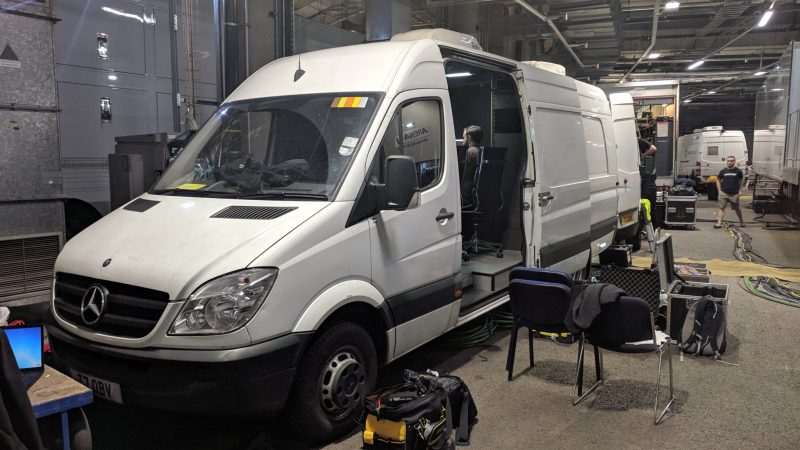
For most of the 73,000 in attendance the key question was, “Who would book their place in the final against Man United?” Our team members were much were less concerned about the result on the field. They were worried by the result on the screens.
The truck we used, thanks to the invaluable assistance of BT Sport, allowed us to test in a live environment a range of tools and systems that have been developed by the project. We learned an enormous amount by being in the middle of a major outside broadcast and through meeting a number of suppliers and colleagues who were centrally involved in delivering it.
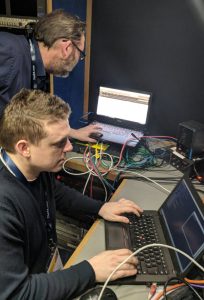
We were thrilled that the 2-IMMERSE was recognised and supported – and importantly that we are now better known to some of the outside broadcast teams whose support we will rely on for our next two live tests. Inevitably, and as you would expect from such a test, we spotted a range of bugs and problems, and we are now busy examining the logs to see if we can identify their causes – and the mend them.
While our team went home with a bug list and deeper knowledge of how the outside broadcast process interacts with our system, Chelsea went home victorious. So the FA Cup final that we will be using in our live trials on Saturday 19 May will be between Manchester United and Chelsea. Prior to that, as the footballers get measured for their match-day suits, we have some bug fixing to attend to and, thankfully, another live test to complete before we conduct a pioneering object based broadcast test of the 137th FA Cup final.
With thanks to Martin Trimby for the photographs.
READ MOREMotoGP – “nearly there”
DOUG WILLIAMS from BT R&D reports on our first user testing for the 2-IMMERSE MotoGP prototype:
Back in November 2017 we started evaluation of our MotoGP service prototype with people (real, ordinary people!) who were using it in their own home. The MotoGP service prototype is a multi-screen experience delivered via our cloud based micro-service infrastructure. The key group whose opinion we sought was people who already watch MotoGP on TV, and we wanted their feedback about our new multi-screen experience. (If you’re not familiar with our MotoGP experience you can see our video of it here.)
The results from the first 85 respondents are in and we are beginning to get to grips with the mountain of data and comments. We are, our users tell us, nearly there.
We asked our users to assess the value of the features we provide on a scale of 1-10 (where 10 is good). The details of all the features are described here.
Overall, the results are very encouraging. We sought evaluations of the different features we offered and for each participant to comment on their ease of use. As can be seen in the graphic below, scores approached 9/10 for all features – from which we have to conclude that we have done something right.

No, not everything was perfect. Some users experienced absolute failures (it is a prototype); some found the joining process a little tricky:
getting the sequencing right connecting the right thing to the right WiFi at the right time was a bit of a faff.
Some thought the responsiveness could be better, and some wanted an ‘undo’ capability. Also when asked about the level of control users had in our prototype, 88% said they wanted more control over how the video and graphics were laid out across all the screens.
The prototype, our users told us, was not perfect. Certain features that we were really keen on, such as the ability to adjust the graphics size so they better suit the size of your TV, and the ability to change the way the leaderboard was presented were, in terms of perceived value, ranked towards the bottom of the 8 broad features we assessed.
Overall, however, 9 out of 10 for all features is feels very positive. And feedback like this is very encouraging:
I would just say it’s worth getting. Really good for MotoGP… this is the future of TV… [I] don’t expect to watch [MotoGP] the same way again.
User feedback in projects like this is essential, but it is not the whole story. Feedback from the production industry is also critical – and that’s why we recently took the MotoGP to NAB. See this post to read about what industry insiders thought.
READ MORE2-IMMERSE at NAB 2018
The trade fair, exhibition and conference NAB is one of the fixtures on the calendars of all the key influencers in the broadcasting industry. NAB, which took place 7-12 April in Las Vegas, and its sister conference IBC, in Amsterdam 13-18 September, are great litmus tests for what is important for the industry. This year the idea of immersion was strongly featured and there was a great deal of interest in high resolution VR technologies.
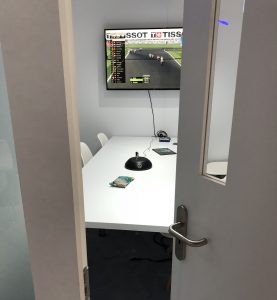
ChyronHego, partner in 2-IMMERSE and provider of sports graphics and data to the broadcasting industry, took to NAB our project’s interpretation of what immersion can mean. ChyronHego used the multi-screen object based broadcasting concept demonstrated by the MotoGP service prototype (which can be seen in this video) to showcase the way we believe we can immerse viewers in an experience across multiple screens.
With private demonstrations in meeting rooms on the ChyronHego stand (the main stand is above, our demo set-up to the right), the work assumed a slightly mysterious hue. Since it remains a prototype, it was inappropriate to place our MotoGP demo front-and-centre of the ChyronHego stand, since such space is reserved for today’s products.
In private presentations, however, the work was introduced to many key influencers from more than 15 different broadcasters based in Germany, Switzerland, Sweden, USA, Norway and the UK. ChyronHego’s Director of Software Development Stefan Fjellsten, who led the interactions, was delighted with the response:
It exceeded my expectations. Everyone was really positive with some asking for exclusive rights to the technology in their territory, and all of them trying to work out how the capability could be applied for the content rights they have.
The feedback and interest we garnered through this comparatively low-key display of our ideas at NAB is really encouraging. Alongside the feedback we are getting from users it suggests strongly we are following a path that interests providers, rights holders and their viewing public. It also prompts us to be bold as we plan to provide a more comprehensive display of the project’s results at this year’s IBC iin the early autumn.
Thanks to Stefan Fjellsten for the photographs.
READ MOREMediaSync: a new handbook
PABLO CESAR (above, right, with co-editor Jack Jensen) from 2-IMMERSE partner CWI, Amsterdam, celebrates the publication of a new edited collection from Springer:
In March 2015, Springer approached my colleagues and me because of our workshop on Media Synchronization at the ACM International Conference on Interactive Experiences for TV and Online Video (ACM TVX):
I do hope you will forgive me for contacting you out of the blue. The topic area of the workshop looks really interesting and I wonder whether you might want to consider using the material discussed as the basis for an edited book.”
I thought that it was the right time, and the right publisher, to edit such a book. A scholar or practitioner interested in media synchronization needed to find their way from a set of scattered works. Given the number of disciplines considering this research area (from human factors to networking and from multimedia systems to document engineering), not all the works were consistent in terms of concepts, definitions and assumptions. I believed an approachable overview was needed, covering the broad media synchronization area from different angles and perspectives.
After three years, tons of hours, thousands of emails, several delays, and some frustration, the book MediaSync: Handbook on Multimedia Synchronization was in my mailbox. The result: over 60 authors, 23 chapters, 679 pages, 241 illustrations, 193 colour illustrations, 60 authors; a foreword by Ralf Steinmetz and an afterword by Dick Bulterman.
Some of the benefits of the volume include:
- A unique reference and perfect companion book about the fascinating media synchronization (mediasync) research area
- Provides a comprehensive overview of the mediasync research area from complementary perspectives, such as theoretical foundations, available technologies, use cases, standardization efforts and experimental studies
- Paves the way for overcoming remaining challenges towards the deployment of next-generation multimedia systems
- Includes chapters from the most representative and influential experts in this area
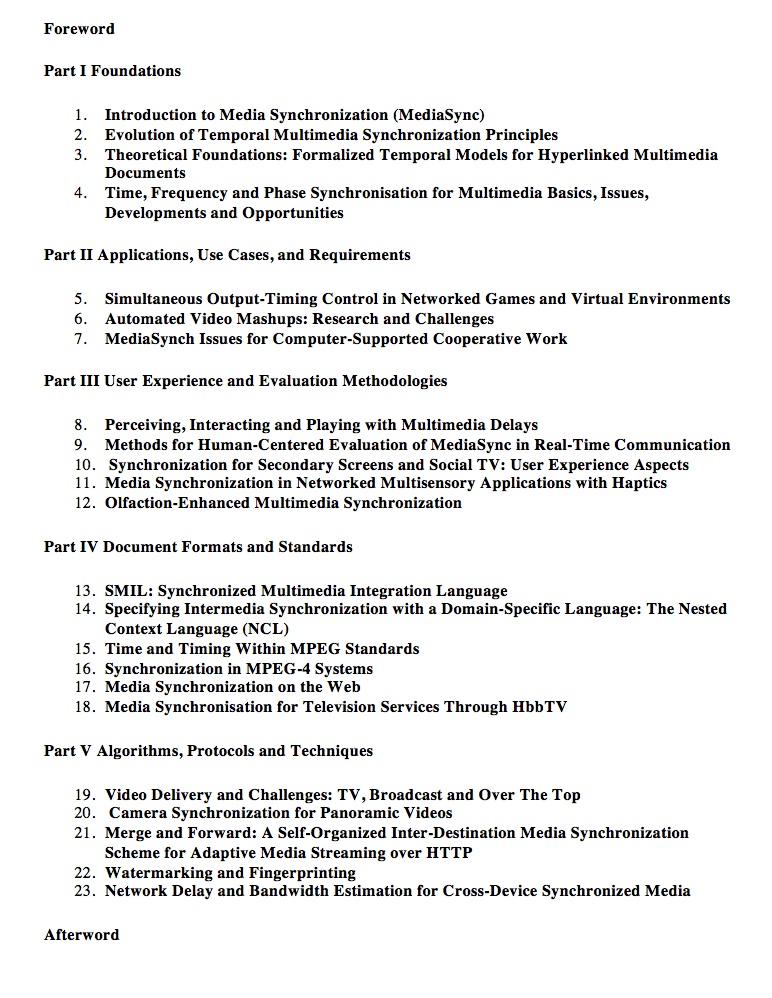
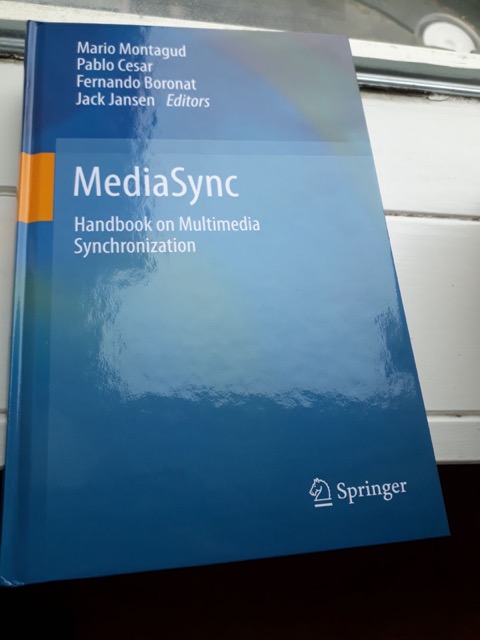
Summary
This book provides an approachable overview of the most recent advances in the fascinating field of media synchronization (mediasync), gathering contributions from the most representative and influential experts. Understanding the challenges of this field in the current multi-sensory, multi-device, and multi-protocol world is not an easy task. The book revisits the foundations of mediasync, including theoretical frameworks and models, highlights ongoing research efforts, like hybrid broadband broadcast (HBB) delivery and users’ perception modeling (i.e., Quality of Experience or QoE), and paves the way for the future (e.g., towards the deployment of multi-sensory and ultra-realistic experiences).
Although many advances around mediasync have been devised and deployed, this area of research is getting renewed attention to overcome remaining challenges in the next-generation (heterogeneous and ubiquitous) media ecosystem. Given the significant advances in this research area, its current relevance and the multiple disciplines it involves, the availability of a reference book on mediasync becomes necessary. This book fills the gap in this context. In particular, it addresses key aspects and reviews the most relevant contributions within the mediasync research space, from different perspectives.
Mediasync: Handbook on Multimedia Synchronization is the perfect companion for scholars and practitioners that want to acquire strong knowledge about this research area, and also approach the challenges behind ensuring the best mediated experiences, by providing the adequate synchronization between the media elements that constitute these experiences.
READ MORE

